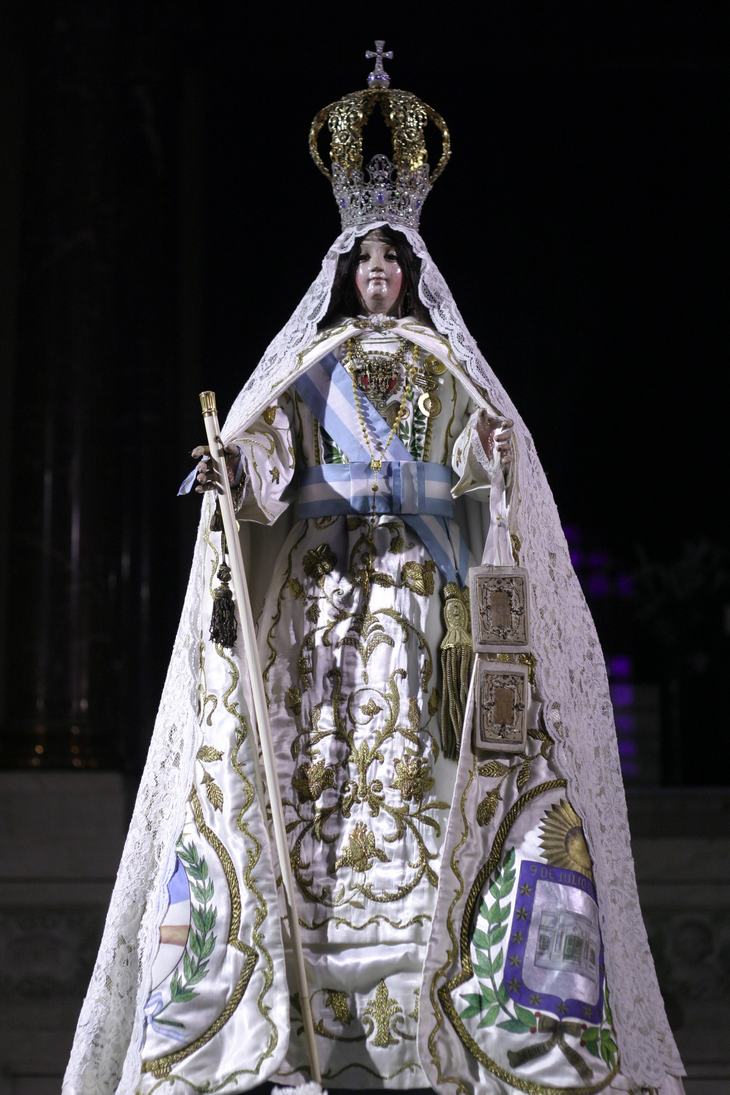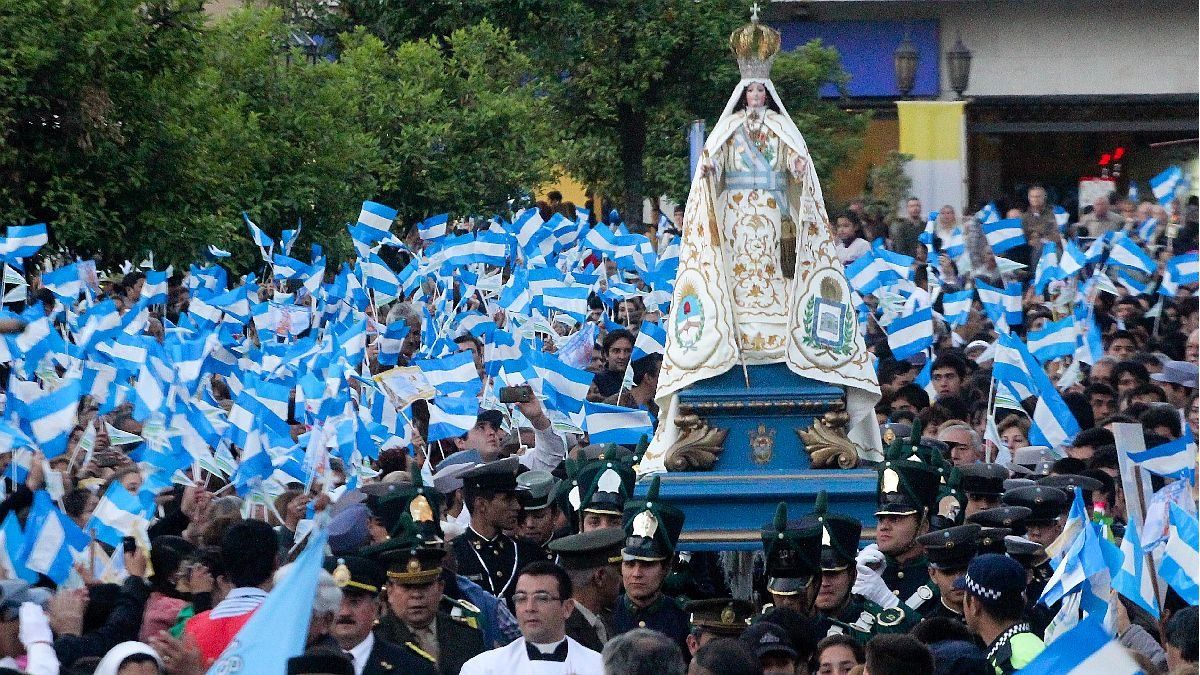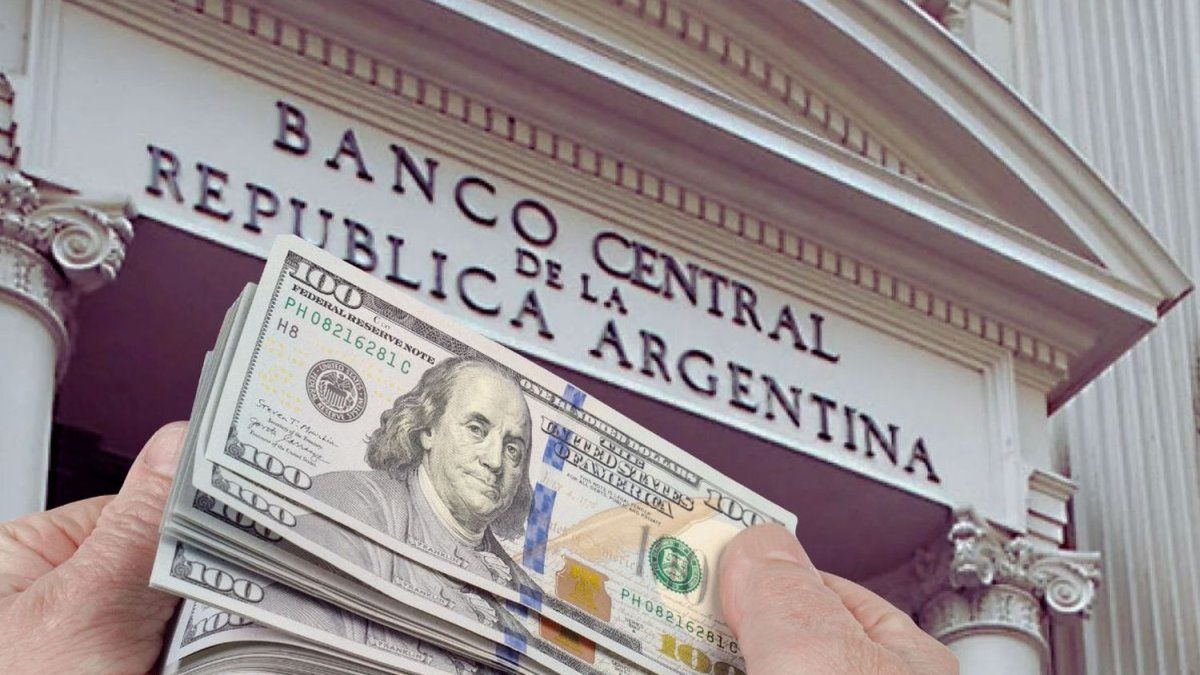The Our Lady of Mercy Churchlocated in Villa de Medinas, 90 kilometers south of San Miguel de Tucuman, houses the oldest image of the Virgin of Mercy in Argentina, sculpted and carved in semi-hard wood, covered with gold foil, dating from the year 1600. Although every July 15 this community commemorates the coronation of the Virgin and the faithful congregate to renew the vows of Faith, September 24 is the date that unites the celebration of the Day of the Virgin of Mercy to the parishioners, not only of this community, but of the entire province. The devotion covers every corner of Tucumán and remains in force since the birth of this province.
Tucumans have a particular devotion to the Virgin of Mercywhich is the same Virgin that has been accompanying the city since the moment of its foundation, in the first settlement of Ibatín, in the south of the province, back in 1565. The Mercedarian Basilica, named since 1813 Parish of the Victory by request of the General himself Manuel Belgranoin gratitude for the protection of the Virgin in the epic battle of the previous year, is the epicenter of this patronal festival, just one block from the city’s main square.
Our Lady of Mercy Church Tucumán.jpg
The descent of the Virgin towards the atrium of the church takes place 40 days before the culmination of the festival. This year the motto of the celebration is “Happy you for having believed in love”, with the practice of the Novena from September 15 that concludes on the 24th, with the procession through the streets of the city of San Miguel.
The history of this invocation of the mother of Jesus dates back to the 12th century. Of Spanish origin, the story tells that the image appeared to the religious Saint Pedro Nolasco to ask him to found an order that could free enslaved Christians under the power of Muslims. Later, with the arrival of the Spaniards to the continent and especially with Pedro de Mendoza, the first Mercedarians arrived in this region of northern Argentina and this is why the devotion to Our Lady of Mercy is one of the oldest in the country.
“Merced” means mercy, gift, grace and also forgiveness, that is why the name of this dedication alludes to the mercy of God with his children, who left in the person of the Virgin Mary an authentic mother, a channel of grace and a wise intercessor. The Mercedarians, apart from the vows of poverty, chastity and obedience, made a fourth vow, in which they promised to dedicate their lives to freeing slaves, and, if necessary, to stay in place of some captive in danger of losing faith. , or for which there was not enough money to secure his release. Many of them gave their lives, taking refuge in the “Mercy” of Our Mother.
For the many favors that the Virgin of Mercedes dispensed to the people of Tucuman, the Cabildo in 1687 named her Patron Saint and Lawyer of the city. In 1696, Pope Innocent XII set September 24 as the date on which her feast should be celebrated. The Order of Mercedarians has been in charge of spreading the devotion to Our Mother under said invocation, spreading throughout the world throughout the centuries. It is known that when the Mercedarian friars arrived in America, they introduced this beautiful devotion. That is why today, the Virgen de la Merced (or, de las Mercedes) is celebrated by devotees from the Dominican Republic, Peru, Ecuador, Argentina and many other countries on the continent.
Virgin of the Mercedes, Holy history of Argentina
If you retrace Argentine history a few years after Independence, you will find in Tucumán another milestone that set fire to the formation of the Homeland. 1812 is the year, the outskirts of the city the place, Manuel Belgrano and the Army of the North the protagonists, and the Virgen de la Merced the maker of a miracle that meant victory for the national troops and the permanent adoration of a believing and faithful people.
Ignoring the orders of the Cabildo of Buenos Aires, which required General Belgrano to continue towards Córdoba the retreat he was carrying out with his exhausted soldiers coming down from Jujuy, the creator of the flag sought help and solace under the mantle of the Virgin of La Merced, in Tucumán. Ordering his few troops and reinforced by the fervor of the city’s inhabitants, he decided to wait there for the royalist army commanded by Pío Tristán, who doubled his number and decided to push the Crown limits as far south as possible.
The fury of the defenders, the courage of the soldiers under Belgrano’s command and the help of nature that caused a strong storm of wind and earth, with an unprecedented swarm of locusts that September 24, disoriented the Spanish troops who were devastated and they had to beat a retreat. This chapter set fire to the future of the country, because the northern border of the future Argentina could be defended thanks to the courage of this brave and proud people. Manuel BelgranoGrateful, he offered the Virgin of Mercy his baton and named her General of the Army of the North, as if closing a circle under the miracle of faith. This historical scene took place in the same procession that day, when the General lowered the litter to the ground where they carried the image to carry out this act of gratitude.
image.png

The nuns of Buenos Aires, learning of these acts of devotion, sent Belgrano four thousand scapulars of the Virgin of Mercy so that he could distribute them to the troops. Before leaving for Salta, the Tucumán battalion gathered in front of the atrium of the Merced temple, where the scapulars were delivered, and the chiefs, officers and troops placed them on their uniforms.
In the Minor Basilica Our Lady of La Merced, also called the Parish of Victory, that Baton of Command with a gold handle is preserved as a relic. There is also a flag there that was taken from the royalists during the Battle of Salta in 1813, but the most precious treasure in this temple is the first Argentine flag in Tucuman territory and the second in the country, the one raised by Creole troops in the battle of 1812.
On February 20, 1813, the Argentines seeking their independence clashed again with the Spanish in Salta. Before going into combat, Belgrano reminded her troops of the power and value of María Santísima and exhorted them to put her trust in her. He also made a vow to offer her the trophies of victory if through her intercession he obtained it.
With the help of the Mother of God they defeated the Spanish again, and of the five flags that fell into Belgrano’s power, one was destined for the Virgen de las Mercedes de Tucumán, two for the Virgen de Luján and two for the Cathedral of Buenos Aires.
Useful data:
Our Lady of Mercy Basilica – La Victoria Parish
Location: Calle 24 de Septiembre 253 corner of Virgen de la Merced, one block from Plaza Independencia and the Cathedral of Our Lady of the Incarnation. Telephone: (0381) 421 5965
Mass times: Monday to Friday 7.15, 18.30 and 20.00. Saturdays and holidays 8:00, 18:30 and 20:00. Sundays 8:00, 11:00, 18:30 and 20:00.
Prayer of the Novena, patron saint festivities of the Virgen de la Merced: from September 15 to 23 every day at 6:30 p.m. and 8:00 p.m., the latter being presided over by the Archbishop.
September 24, the day of the Virgen de la Merced: the acts in the Basilica will begin at 0.00 with the greeting of the gauchos to their patron saint. Then, there will be masses at 6, 7, 8, 9 and 11.00.
At noon the image will be taken to the School of the Slave Sisters. At 5:30 p.m. the procession will begin, from Plaza Belgrano, through Alberdi and 24 de Septiembre streets to Plaza Independencia.
The central mass will be at 7:00 p.m. At the end of the celebration, the image will be transferred to the Basilica and as a closing of the festivities, the Popular Mariana Festival will be held.
Source: Ambito
David William is a talented author who has made a name for himself in the world of writing. He is a professional author who writes on a wide range of topics, from general interest to opinion news. David is currently working as a writer at 24 hours worlds where he brings his unique perspective and in-depth research to his articles, making them both informative and engaging.




